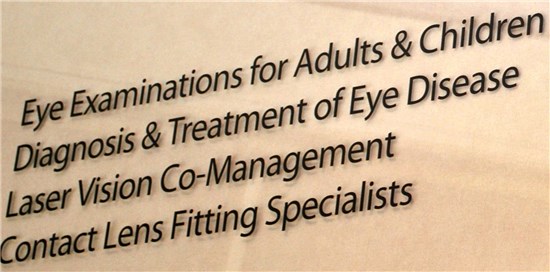By Thuy-Lan Nguyen, OD
Feb. 10, 2016
SYNOPSIS
Medical model optometry holds tremendous growth potential for your practice, so let patients know that you provide it. Here are nine ways to get the word out.
ACTION POINTS
PROVIDE MEDICAL INFO ON WEB SITE. Post clear and concise information about the conditions you manage and photos and info about instrumentation.
HIGHLIGHT SERVICES IN MARKETING MATERIAL. Highlight the doctor’s name and web site on every piece of paper, business card and brochure with info about services.
EMPHASIZE IMPORTANCE OF EYE HEALTH IN EXAM. Let patients know that you prescribe glasses and contacts, but the most important part of any examination is to evaluate their full ocular health.
Your patients may not realize that you do more than refraction and the fitting of contact lenses. Marketing the medical eyecare services you provide is essential to practice growth and profitability.
I formerly owned a practice in Pembroke Pines, Fla., in which I was conscious of communicating a message of full-scope medical eyecare to both my current and prospective patients.
ODs have an expanded scope of practice, which you can take advantage of to grow your practice. There is tremendous growth potential in managing diseases like glaucoma, diabetic retinopathy and macular degeneration. Optometry is challenged on profits on the optical side with competition from big box retailers and online sales. Emphasizing the medical model can more than make up for that.
Feature Info About Medical Eyecare on Web Site
An optometric practice’s web site should be a source of medical information for patients, but first it has to be professional, modernized and easy to navigate. Savvy consumers now can tell when a web site is out of date. Even if a practice actively markets on social media, the web site is still a major influencing factor in a patient’s decision of whether to make an appointment.
Practices should consider providing information and links for medical conditions that they treat. For example, post clear and concise information about diabetic retinopathy. Then provide a link to the American Diabetes Association web site for more information. Then show pictures of the equipment in the office such as retinal cameras or OCT with photos of diabetic retinopathy. The links to related web sites increases search engine optimization, and photos of your equipment makes it more familiar for the patient when they are in the office. Then keep information current by adding to, or changing, the links periodically. Consider writing blogs about recent cases to demonstrate the doctor’s expertise, and to gain trust.
Advertising your medical eyecare services in your office lets patients know that you are the doctor to see not just for glasses and contact lenses, but to monitor and maintain their eye health, as well.
Front Desk Should Communicate Medical Eyecare Services
Your receptionist should get into the habit of collecting vision insurance information, as well as medical insurance information. It’s a lot of work, but worth it in the long run. Even if the doctor is not a direct provider for the patient’s plan, the receptionist should always have a conversation with the patient about their medical insurance. Then, once the appointment is scheduled, the receptionist should invite every patient to visit the practice web site for more information, and to read about the doctor’s experience and health care expertise.
Highlight Medical Eyecare In Office Marketing Materials
Highlight the doctor’s name and web site on every piece of paper, business card and brochure in the office, not just the practice name address and phone number. Even if the opticians have business cards, it should list the employee’s name, but also the doctor’s name and title. This reminds patients while they are purchasing glasses from the optical, the practice is driven by the doctor’s services. Even the practice logo could reflect the medical care provided, not just the optical side.
Ask About Overall Health in Intake Form
Intake forms should ask about the basic 14 review of symptoms, the patient’s medical and family history, but also ask who the patient’s primary care physician is and when their last physical examination was, as well as lifestyle information. Ask patients if they smoke or drink alcohol, how many times a week they exercise and other activities they enjoy outside of work. Intake forms should also ask the patient’s preferred pharmacy location, and if they see any other specialist.
Educate Patient About Eye Health During Pre-Testing
Technicians are critical in setting the tone for the examination. By asking their chief complaint and triaging, techs can help dictate what type of examination the doctor will perform. They should collect full medical and family medical history from all patients as part of the case history and preliminary testing. Techs should rehearse over and over scripts explaining each test and why it’s done. Technicians should be accurate and consistent with every single patient. If a practice has more than one tech, everyone should memorize the same script. Technicians should also confirm the patient’s primary care physician’s name and address, as well as the patient’s pharmacy of choice and any other specialist they see.
Emphasize Importance of Eye Health in Exam Room
It’s important for all patients to know that you prescribe glasses and contacts, but the most important part of any examination is to evaluate their full ocular health. If the patient has good vision, the goal is to keep their vision good. And if there are any eye diseases discovered, patients should know that their optometrist is comfortable with, and in control, of overseeing their treatment, even if surgery is indicated. Your ability to co-manage with surgeons, and other MDs, should be explained.
Health care reform is presenting additional opportunities to educate patients. The goal of reform is to increase preventative care. More patients who don’t require glasses or contact lenses may present for a comprehensive eye exam because they now have insurance coverage. Use even straightforward cases as an opportunity to discuss the connection between eyecare and medical care. Talk to patients about other holistic care such as the ocular benefits of leafy green vegetables, vitamins, exercise and stress reduction.
Explain Scope of Your Services in Exam Room
Every patient is an opportunity to increase awareness. So, when a patient tells me they only want their glasses checked, and that they get their eyes examined with an ophthalmologist, I say, “That’s great! I will work closely with your ophthalmologist to keep your eyes healthy.” Explain to patients that today’s examination will determine whether whatever medical condition they have is affecting their vision, or if they need to see an ophthalmologist urgently. A letter should be sent to the ophthalmologist to inform them of the full examination findings.
Participate in Community Health Fairs
Community health fairs, speaking to local schools and reaching out to other physicians in the area is a fantastic way to let the community know that ODs are capable of diagnosing and treating medical conditions. Get involved with charitable causes in the community, such as cancer walks and fundraisers for ALS, diabetes or whatever you are passionate about. Get the staff involved, and make your practice known in the community. Post your involvement in these philanthropies on social media to get your patients informed and involved.
Reach Out to Local Physicians
Sending letters to other physicians is critical when building or growing a medical optometric practice. Even if a patient is only coming for their glasses and contact lenses, send a letter to their PCP informing them that a dilated retinal examination was performed. If a patient does have an eye disease such as glaucoma, which requires long – term ocular medications, send a letter to their physician to inform them of the diagnosis and treatment plan. Send a letter to the pediatrician of every young patient who is examined. Primary care physicians should also be informed of acute cases, such as keratitis or uveitis. Most EHR programs can produce a summary letter quickly. This reinforces the importance of optometry in medical care to the patient and their other physicians.
Thuy-Lan Nguyen, OD, practices in South Florida and teaches at Nova Southeastern University College of Optometry. To contact her: TLNGUYEN@nova.edu


























